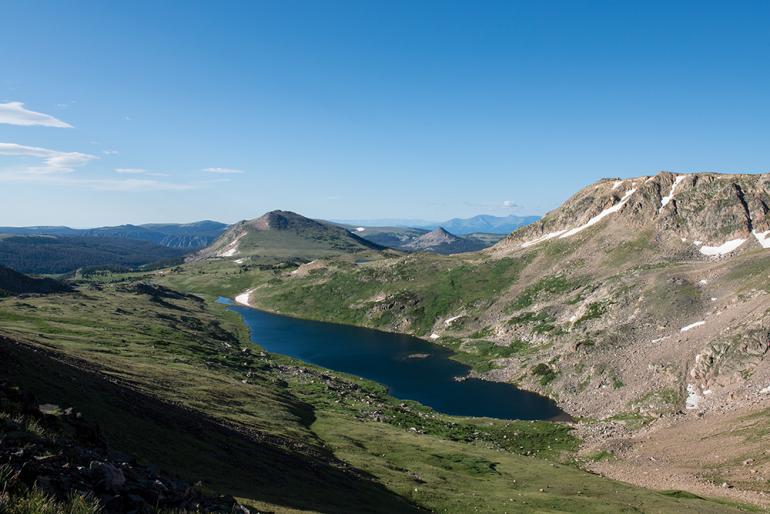Angling at Altitude
Pursuing cutthroats, goldens, and grayling in thin air.
Stumbling out of my tent in the soft light of dawn, I wondered if the fish would be in a similar less-than-lucid state. At 8,400 feet, deep in the Gallatin Range, our campsite was cool. I slipped on a sweater, crept down the bank, and gazed at the lake’s color continuum: peppermint near the shore, blending into teal, and finally a rich navy blue.
Kneeling in the mountain’s shadow, I searched for cruising cutts. There—a lengthy specimen, meandering the shoreline. Out went a flying-ant pattern and I soon hooked the strong, 17-inch Montana blackspotted cutthroat trout. As the fish leaped and splashed, a gray jay clucked, the sun broke the ridgeline, and alpenglow set the surrounding slopes ablaze.
Now, thinking back on that misty morning in the high country—touching the trout’s cool, colorful skin, breathing the fresh mountain air—I’m reminded of a line from Bob Seger: “Those are the memories that make me a wealthy soul.”
Wealthy, indeed—just like the riches of southwest Montana’s mountain lakes. From the Beartooth Mountains to the Idaho border, hundreds of alpine tarns hold native cutthroat trout, eager Arctic grayling, and elusive and gorgeous golden trout. These fisheries require more effort to get to, and they lack the big-finned browns that many folks lust for; but they reward ambitious anglers with exquisite backdrops, native fish, and the feeling that you did something worthwhile.
And don’t think you can’t catch a kype-jawed 20-incher just because you’re in the sterile, clean, thin mountain air. You can—and will, eventually, if you spend enough time up high, alone in the alpine air, angling at altitude.
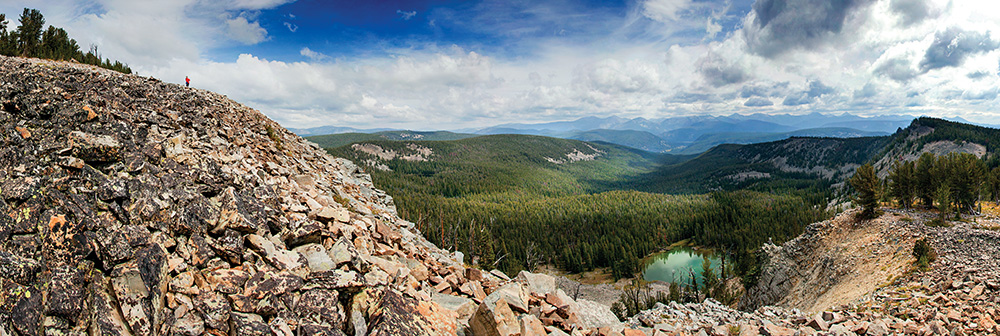
Bobcat Lake
Where to Go
The first factor to consider when choosing a mountain lake is whether or not it is stocked. The Montana Fish Wildlife & Parks website FishMT is the best source for this information—select the Stocking menu item and enter the lake’s name to see if, when, and how often it is stocked. Most stocked lakes receive two-inch trout every four years, almost exclusively cutthroat nowadays (Yellowstone cutts in the Yellowstone River drainage, westslope cutts everywhere else in our area). Timing the stocking cycle so that the fish have time to grow big is a trick to finding larger fish at stocked lakes—think five to six years after a stocking for some potential donkeys.
Don’t fret if the lake hasn’t been stocked recently, as it could actually have the more desirable “self-sustaining” (or wild) population of fish. This is often considered better because it means that fish are produced every year, rather than every four, and there should be small (young and easy), medium (appropriately challenging), and large (old and memorable) fish every year.
Another tip for finding larger fish is to target lakes between 6,500 and 7,500 feet in elevation. Lakes in this range have longer growing seasons and provide more food for fish to grow longer, wider, and faster. Lakes in this range are where most of my most memorable fish have come from.
A bit of skepticism is wise when swapping stories, as rumors run rampant about highland trout. A few years ago my wife and I hiked deep into bear country to fish for the alleged golden trout of Upper Coffin Lake in the mountains west of Hebgen Lake. After hours of fruitless flailing without so much as a tug or swirl, we returned home to learn that, despite being told by multiple (unofficial) sources that Upper Coffin held goldens, and despite having been stocked with goldens in the past, Upper Coffin Lake was in fact fishless.
That holds true for most mountain lakes—if it has never been stocked, it is likely fishless as trout are not native above about 7,000 feet in this area.
A fantastic local option for Arctic grayling is Emerald Lake, which is loaded with hungry grayling. Beyond Emerald is beautiful Heather Lake, which hosts sizeable but stubborn cutthroats. For goldens, try the, well, Golden Trout Lakes, up Portal Creek in the Gallatin Range, which only requires a quick two-mile hike.
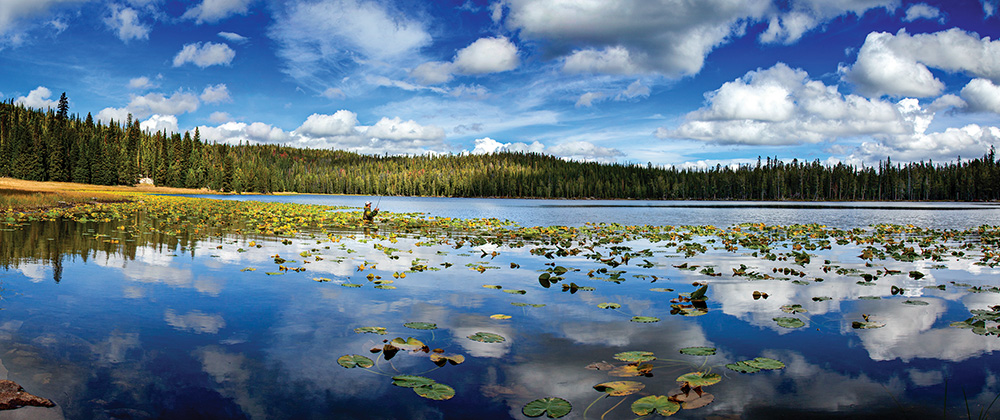 Odell Lake
Odell Lake
What to Use
Five-weight rods, weight-forward floating fly lines, and standard river flies will get the job done at mountain lakes, but specialized equipment can provide an edge.
For example, a 7.5-foot 3- or 4-weight rod can be easier to hike with, more fun to play fish on, and easier to cast in conditions where the trees encroach on the lake (or inlet or outlet creeks). Switch rods, which can be cast both single-handed or with the two-handed spey style, are great for long roll casts when there’s limited room for a back cast.
A curated selection of flies will keep your fly box small. At a minimum, alpine anglers should tote a selection of wooly buggers, leeches, scuds, chironomids/midges (larvae, pupae, and dries), callibaetis dries, ants, and beetles. More robust collections could include a wide variety of sizes and colors of the aforementioned flies, plus hoppers, caddis dries, damselfly nymphs and dries, pheasant tails, eggs, myriad attractor dries, and a few streamers.
Bringing a small boat is an option at some lakes. There are a variety of float tubes and one-man rafts available (some of them suitable for backpacking), and the ability to waft away from the shore can be a game-changer on certain lakes. At drive-to or short-hike lakes, such as Rat Lake in Gallatin Canyon or Branham Lakes in the Tobacco Roots, a canoe can provide new angles from which to approach finicky fish while providing plenty of room for back-casts.
If bringing a boat isn’t possible, bringing something to wade in can get you closer to the fish and further from the trees. The water’s frigid up high and even on a hot summer day, wet-wading will take its toll on your body.
Spin fishing is also effective at mountain lakes, and provides an advantage when there’s no room for a back cast or the fish aren’t rising. Lures like #0 and #1 Mepps Aglias or marabou jigs can be extremely effective in the right circumstances. If you want the option for both spin and fly fishing, Orvis and Cabela’s both sell combo spin/fly rods.
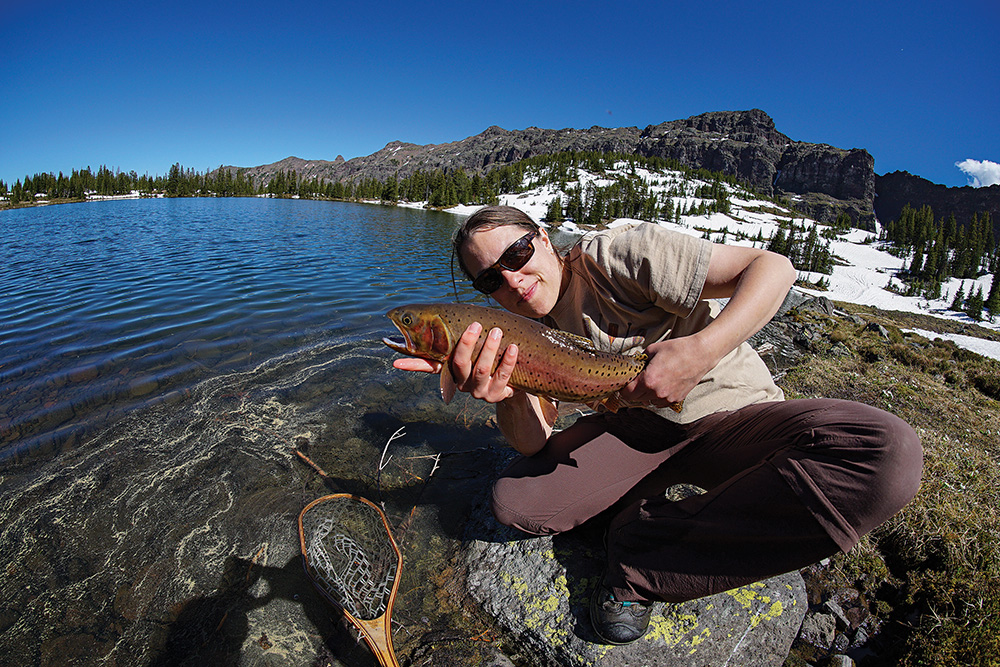
High-alpine spoils
How to Use It
Plopping a parachute Adams at any random spot on a lake will sometimes be all it takes (that’s how I caught my first grayling). But oftentimes, special techniques are required.
Scanning the shallows for cruising fish and casting in front of them often yields strikes. Giving your dries a little twitch now and then can help get the fish’s attention.
Setting flies under a strike indicator, just like in rivers, can also be potent. A wooly bugger over a scud or midge is a good setup to start with. Letting the flies sit stationary or retrieving them at varying speeds helps to determine what the fish are into that day. Using an indicator also helps you fish at a consistent depth, if you’ve determined that the fish are suspended mid-depth.
Going without an indicator can be the right call when the fish are deep (think 5pm in mid-August when the lake’s surface warms), as this allows your flies to get deeper.
A good roll cast is one of the most important fly-fishing skills for prowling mountain lakes. When there’s not enough room behind you, trying to force a standard cast is a recipe for a short, aggravating day.
And if the fish are tight-lipped, don’t be afraid to get downright weird. For example, sometimes stripping midge dries is the ticket. Other times they won’t eat a dry fly on the surface, but will pounce on it five feet deep. Try floating an egg or a three-inch sculpin—curiosity has been the demise of many an alpine cutthroat.
This proved true one afternoon at Hopkins Lake in the East Pioneers. The fishing had slowed and all I could get were last-minute refusals on my foam hopper. So I decided to put the fly closer to the fish by adding a split shot, making it sink. I caught 15- to 16-inch westslope cutts on my next three casts.
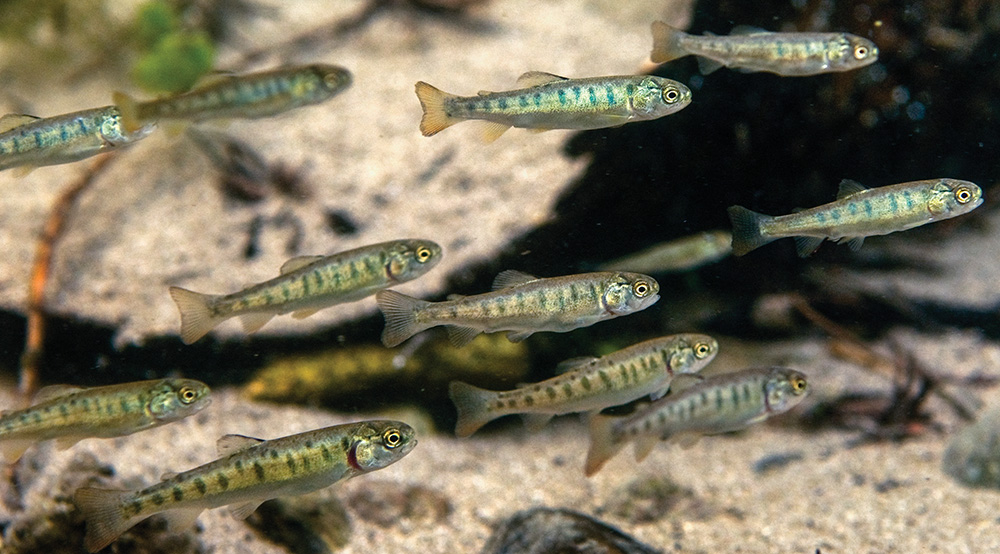
Thin cutt fry
How to Eat It
Mountain ponds are often some of the best places to keep a few for dinner, as many are put-and-take fisheries (meaning they’re stocked and not self-sustaining, so anglers might as well pluck a few from the herd). Also because it means you don’t have to pack dinner—as long as you’re confident, of course, in your ability to produce.
There’s no need to get fancy when cooking—fresh fish after a long hike always taste good. Gut the fish, wrap in foil with some butter, and place on the campfire coals. Remember to discard the entrails well away from your camp, lest you attract dangerous backcountry scavengers.
Another simple method of backcountry fish-preparation is to poach them (boil, that is, not fish without a license), with a cube of chicken bouillon and spices. And of course frying fillets in oil is always delicious. Add some rice, veggies, or potato-chips crumb for a flavorful feast.
The remainder of that weekend at 8,400 feet in the Gallatin Range offered tough fishing—refusals, denials, near-misses, and eventually, one more hook-up and subsequent break-off. It was humbling, but not in vain, because I learned a couple of important lessons: don’t disrespect mountain trout by thinking they’re dumb, and time spent at mountain lakes is always worth the effort.

